It is difficult to divine how the slavery problem is to be settled; but one thing is certain, that the control of the slave interest in the politics of the continent is done forever...We have nothing doing in science or letters. Of course our plans on the Back Bay must wait for the restoration of tranquility.
The Institute was unable to open its doors officially as a teaching institution until February 20, 1865, nearly four years later. At the time, the United States as a whole had launched a fundamental and major change created by the occurrences of the war and by the essential Emancipation Proclamation issued by President Abraham Lincoln in 1862.
Rogers's own principles were shaped in part by this new ordinance. He voiced a vision for MIT that was inclusive rather than elitist. "The object of the school," he wrote to Charles W. Eliot in 1865, would be "to afford instruction to all who are prepared to benefit from its teachings ..."

Courtesy MIT Museum
Background
Rogers was also influenced by a longstanding family tradition of social liberalism, even political radicalism. His father Patrick Kerr Rogers was a native of Ireland. During the Irish Rebellion of May 1798, he had contributed to Dublin newspapers some articles considered defiant, even hostile, to the British government. To dodge arrest, Patrick fled to the United States at the end of the 18th century. He went on to study medicine at the University of Pennsylvania under Benjamin Rush, an abolitionist.
Born in Philadelphia in 1804 as the second of four brothers, William Rogers spent most of his life in Virginia. The sons inherited a love of mathematics and science from their father, now a physician and scientist who taught natural philosophy and chemistry at Virginia’s College of William and Mary. In varying degrees, the four brothers also shared their father's progressive social and political values.
The eldest brother, James Blythe Rogers, at one point, considered practicing medicine in an African colony of freedmen. The youngest, Robert Empie Rogers, had gone north to New York, with no desire to return to Virginia. Like their father, Henry Darwin Rogers followed the teachings of abolitionist Frank Wright. The three brothers had all gone North, save for William, who stayed in Virginia the longest.
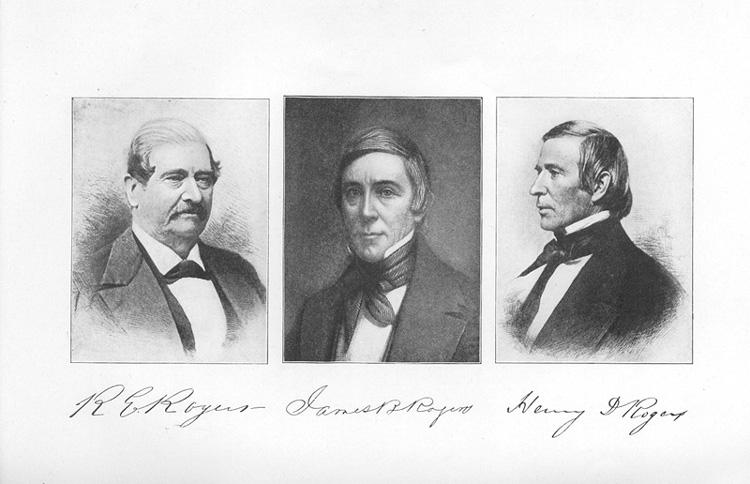
The three brothers of William B. Rogers (from left): Robert Empie Rogers, James Blythe Rogers, and Henry Darwin Rogers.
After his father's death in 1828, Rogers assumed his professorship at William and Mary, where he taught astronomy, chemistry, mathematics, and physics. Rogers then went on to teach at the University of Virginia for the next 20 years.
He and Henry, the middle sons, were similar in their shared professional plans and interests, especially in scientific and academic matters. As early as 1846, the two brothers collaborated on a proposal to establish a technical school in Boston. Their "Plan for a Polytechnic School in Boston" was the rudimentary blueprint for what became the Massachusetts Institute of Technology nearly two decades later. The populist passion that William and Henry brought to the project was evident in phrases such as "great mass of the people" and "inferior classes," implying perhaps that beneficiaries of instruction at the proposed school would come from the ranks of the socially underprivileged.
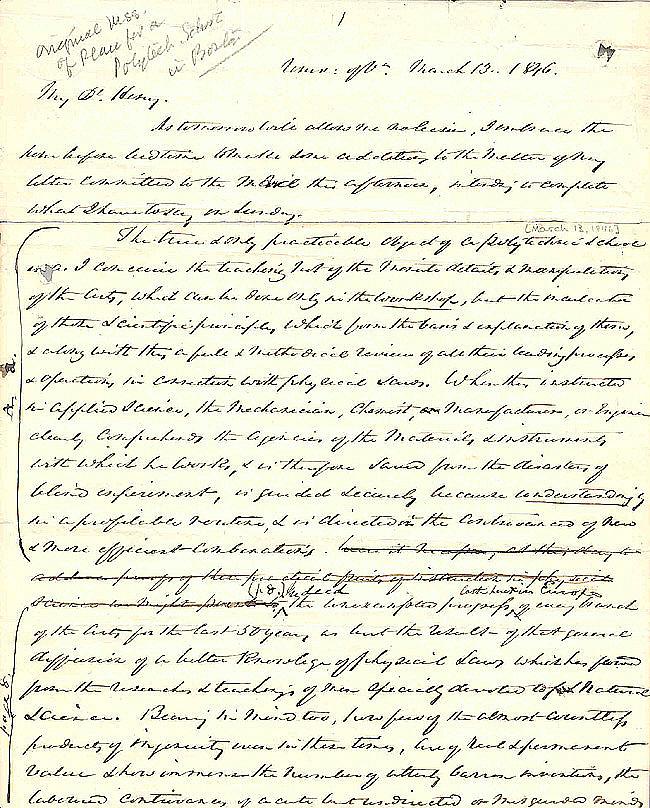
Uniquely MIT, MIT150 Exhibition, 2011:
"In 1846, Henry Darwin Rogers had a conversation with Boston industrialist John Lowell about Lowell’s concept for a new model of higher education. Henry urged his brother William Barton Rogers to put his plan for a "school of practical science" on paper. This letter describes what is considered the original plan for MIT."
Views on Slavery
The earliest enduring comment about race and slavery in William's letters occurred in February of 1851. Writing to Henry, Rogers remarked on the efforts of Southern moderates and conservatives to hammer out an agreement on racial issues:
The Reform Convention is in session [in Richmond], and has entered on the discussion of the basis of representation which is hereafter to be established. All west of the Blue Ridge urge the white basis as indispensable. The eastern members insist on what they call the mixed basis, in which every five blacks are equivalent to two white men. It is difficult to see how the parties can make any compromise, and it is apprehended by some that the Convention will adjourn without settling the matter. There is a large mass of mediocrity in this body, but I believe a good deal of practical sense and much of a reforming spirit...
The expression reflected Rogers's practical if indifferent approval of an assembly that had less to do with genuine reform than with adapting the status quo as a way of defusing the challenge to slavery mounted by the increasingly influential abolitionists. If anything, he believed that slavery promoted a culture of violence, the lowest form of communication, which in turn negatively affects politics and academia.
But living in the South, Rogers appears to have been careful about publicly expressing any "northern" sentiments on slavery that might compromise his professional standing and relationships--and even his physical safety--in the antebellum South. College students were known to burn in effigy professors whose views they disliked. And among Rogers's pro-slavery colleagues in the South, his frequent visits to the North were already enough to elicit suspicion.
Northernbound
In 1849, Rogers married Emma Savage, who would later edit Life and Letters of William Barton Rogers with the assistance of William T. Sedgwick (Boston: Houghton, Mifflin and Company, 1896). She came from a family of abolitionists in Boston. At the time the fast-growing city was a hotbed of daring new ideas, from abolition and free, universal common schools to industrial inventions of every kind. Rogers’ own brother Henry had already moved to Boston and often wrote to Rogers in Virginia about the city up north and its intellectual opportunities.
Antebellum Virginia eventually took its toll on Rogers, despite his care not to upset the status quo. For one, he found that the institution of slavery had created students, many the scions of Virginia’s plantations, prone to interpreting orders from a professor as a breach of their social entitlement. Rogers deemed these students appallingly violent, alcoholic, vain, disrespectful, and anti-intellectual. Case in point was an incident in 1832 in which a student confronted Rogers with a pistol after being reprimanded for riding a horse inside a campus building. According to Rogers, the student yelled "that he had a mind to cowhide" the professor, echoing the master-slave dynamic so familiar in the region. Rogers's own father had once been assaulted by a William and Mary student, who also issued a death threat.
[T]he suspension of three students for disorderly conduct at one of the hotels was immediately followed by a parade at night of a like band, but more noisy and more numerous, attended by attacks on the dwelling of the Chairman and the hotel referred to, in the course of which a door and windows were broken.
In 1853, Rogers and Emma moved to Boston. Now in the North, surrounded by the abolitionist activities in the city, the Southern side of Rogers sternly criticized abolitionists and others in politics in a letter to Henry (9 Sept 1856). In Rogers's view, abolitionists encouraged "the aggravation and outrage of the slave power". He labeled as "good conservative doctrine" the policy advocated by moderates who would "let slavery alone were already established, and ... make no more slave States north of the compromise line," the so-called Mason-Dixon line.
Rogers expressed mixed feelings about John Brown's raid on the federal armory at Harpers Ferry in Virginia, believing the insurrection to be misguided:
The contrast between the trembling fears of a whole State and the resolute bravery, for principle's sake, of one man is most impressive....But he forgot the horrors and crimes of a servile revolt...and he must have been strangely ignorant, or deceived, to believe that he could aid the general emancipation of the slaves by such an attempt. He might have given occasion to an appalling loss of life, perhaps almost to the extermination of the blacks in Virginia...Little as I can sympathize in John Brown's insurrectionary projects, I believe that the panic will bear good fruit by and by in hastening the legislation which was once in Virginia so near arranging a plan of prospective emancipation.
William B. Rogers to Henry D. Rogers, 29 Nov 1859 and 2 Jan 1860
Rogers, who "[knew] well the horrors of an apprehended [slave] insurrection," also worried about what would happen to Southern landowners. He supported what he considered Lincoln's middle-road intention to keep the North slave-free without insisting on immediate and wholesale dismantlement of the system in the South. His attention generally focused on slavery more as a source of national disruption rather than as a violation of the norms of human decency
The Civil War
By early 1861, Rogers's moderate tone had shifted. He became more outraged with the South's warlike spirit. Slavery might well be valid within current constitutional bounds, he argued; however, unlike pro-slavery Southerners, Rogers did not believe that slavery should receive "national protection." He continued to support Lincoln's goal, which, Rogers believed, was not to make war on slavery as it existed in the slave States but, in good faith, to carry out the provisions of the Constitution. His brother Henry nevertheless convinced him that though slavery might be permissible under the Constitution, it was inconsistent with the American system of democracy.
Lincoln's Emancipation Proclamation granted freedom to all slaves, not just to those willing to contribute militarily to the union's cause. Rogers reacted with enthusiasm and relief:
...the greatest event beyond comparison of the war, is the late proclamation of the President, declaring the slaves of all rebellious States after January next to be forever free. On the 22d of September this momentous voice was uttered. On that day in a inspiring sense than ever before--the sun crossed the line...
Rogers's attention throughout the letter, however, is focused once more on slavery more as a source of national disruption rather than as a violation of the norms of human decency:
Our country is delivering herself from the curse which has wrought her such terrible suffering. For all, who understand its cause, will feel that until that is wholly eradicated, we can have no real, enduring peace.
A little over a year later, another letter to Henry (16 Aug 1863) reveals Rogers's most extensive critique about blacks as individuals with human potential, rather than simply as victims in a political battle:
A very important event of the war, thus far, is the proof which the negro has given of his capacity as a soldier...The prejudice against them as auxiliaries or companions in battle, formerly so general among the white soldiers, is rapidly vanishing, and there is every prospect that before the autumn campaign we shall have a large force...of coloured troops, helping ...to secure the freedom of their race. Is not this a grand step forward for humanity? Add to this that the educational commission by its teachers and superintendents...has brought within the folds of a free civilization for instruction and paid industry tens of thousands of fugitives, and of those deserted by their masters, and that their schools and plantations give the fullest evidence of the capacity of these people for knowledge and training, and you will see how much has been done in the last eighteen months to mitigate...the former prevailing belief in the hopeless degradation of our American negroes.
The account corresponded to Rogers's conviction that, with slavery abolished and the war coming to a close, it was time to rid the culture of stereotypes about blacks as primitive and uneducable.
Post-War
On February 20, 1865, six weeks after the end of the Civil War, MIT admitted its first 15 students. Rogers served as president of MIT and taught physics and geology. There is little documentation to adequately determine what his exact views might have been about the admission of black scholars to the Institute (although there is documented evidence of his cautious view of women and women's education). It is clear, however, that MIT was founded as a predominantly white, male institution.
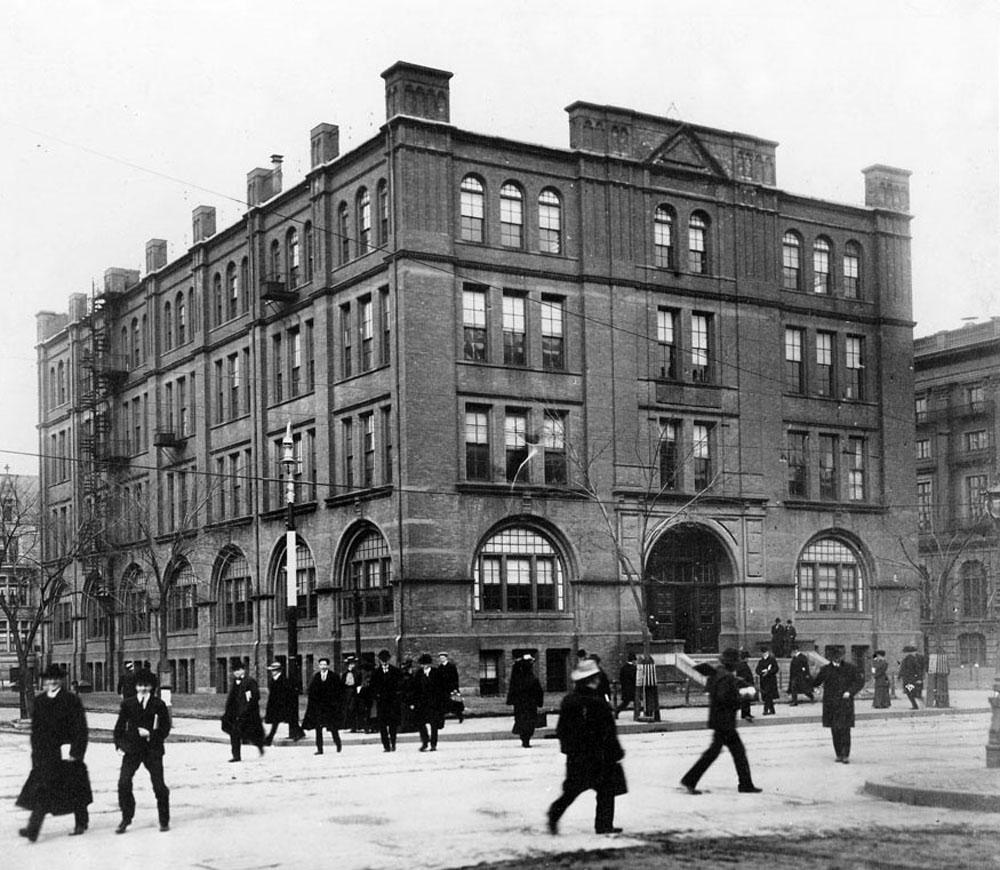

Courtesy MIT Museum
Ten years would pass since its founding before the Institute admitted its first woman student, Ellen Swallow Richards '73. As to racial diversity during the inaugural years, MIT remained typical in allotting servile roles to black individuals.
Over twenty years would pass since its founding before the Institute graduated its first black student in 1892. Even then, traces of both the Civil War and Rogers's educational vision would continue to leave their mark on at least four early black MIT alums:

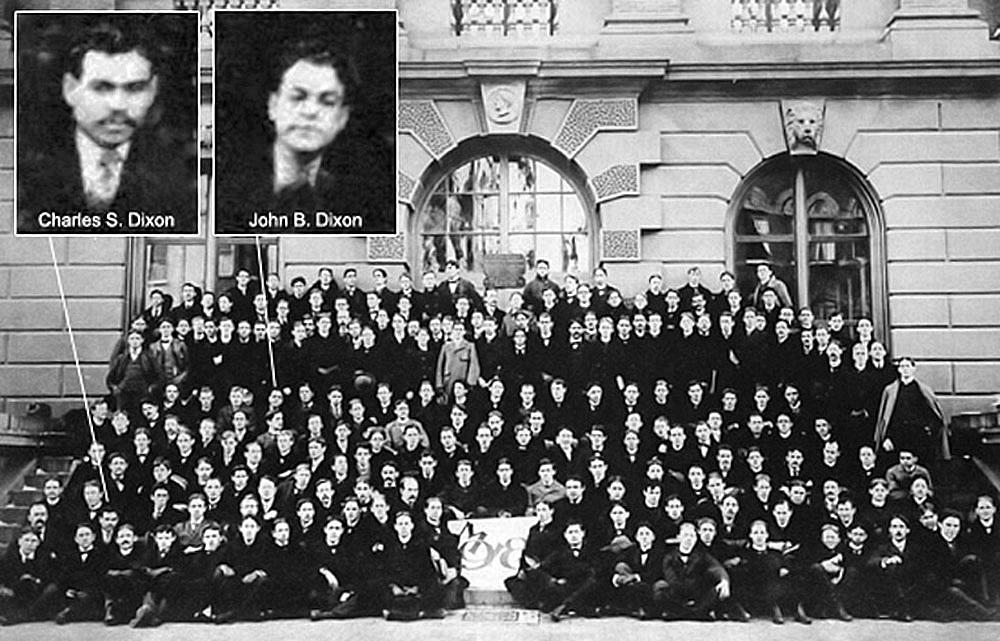
Courtesy MIT Museum

MIT and Slavery
Founded by Craig Steven Wilder, Barton L. Weller Professor of History, MIT & SLAVERY began as a course taught in the Fall of 2017 by Prof. Wilder and MIT Archivist Nora Murphy. The course has evolved into an ongoing undergraduate research project that continues to explore the influence of slavery and race on MIT’s founding and early development, and the connections between slavery and the rise of the sciences and engineering. Students' research projects are published through the MIT & SLAVERY website, hosted by the MIT Libraries.
Colleges and universities across the Americas and Europe are researching their historical ties to the Atlantic slave trade and slavery. In 2017 MIT president L. Rafael Reif initiated a project to research and publish any historical connections between American slavery and the development of the Massachusetts Institute of Technology. Students in the “MIT and Slavery” course are documenting how slavery contributed to the career of William Barton Rogers (the founder of MIT), how it influenced the establishment and early success of the Institute, and how it shaped science and engineering in the Civil War era.
The timing and site of MIT’s founding differs from most of the colleges and universities that are now investigating their links to Atlantic slavery. Chartered in 1861, just two days before the beginning of the Civil War, MIT did not offer classes until 1865 as the war was ending. The Institute was chartered in Massachusetts, where slavery had been abolished decades earlier, and it was originally located in Boston, a city with an active abolitionist minority. Nonetheless, American slavery shaped the early history of MIT in ways that reveal and highlight the centrality of enslaved people’s lives and labor to the region and the nation.
Ebony and Ivy
In Ebony & Ivy: Race, Slavery, and the Troubled History of America’s Universities, MIT American history professor Craig Steven Wilder reveals how the slave economy and higher education grew up together.
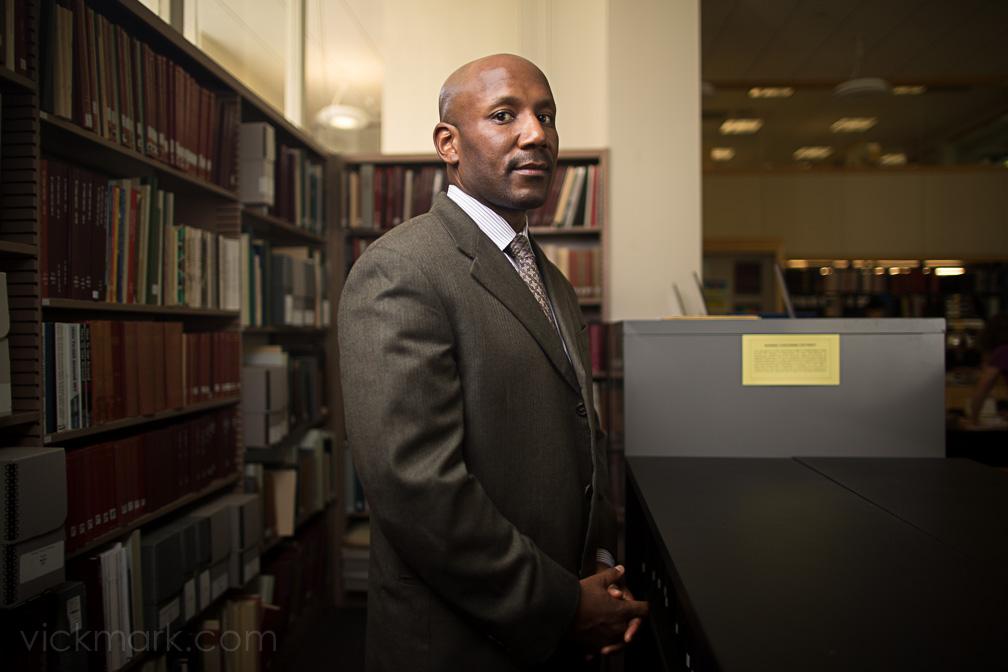
Craig S. Wilder at the Institute Archives, 2013.
Shackles and Ivy: The Secret History of How Slavery Helped Build America's Elite Colleges
Transcript excerpts from MIT history professor Craig Wilder’s two-part discussion with Amy Goodman of Democracy Now!
Airdate: 30 October 2013
AG: So, talk about America’s most elite universities. What relation do they have to slavery?
CW: I think there are multiple relationships. The first and probably most poignant, most provocative, is the relationship to the slave trade itself. In the middle of the 18th century, from 1746 to 1769 fewer than 25 years, less than a quarter century the number of colleges in the British colonies triples from three to nine. The original three were Harvard, Yale, and William & Mary, and all of a sudden there were nine by 1769. And it triples in that 25-year period. That 25-year period actually coincides with the height of the slave trade. It’s precisely the rise and the elaboration of the Atlantic economy, based on the African slave trade, that allows for this sort of fantastic articulation of new growth of the institutional infrastructure of the colonies.
AG: So, let’s talk specifically about particular universities.
CW: Sure.
AG: I mean, you are—you do look at some universities in the South
CW: Mm-hmm.
AG: but also in the Deep North.
CW: Yeah.
AG: Harvard.
CW: It’s a very Northern story, actually. You know, when you think about the colonial world, until the American Revolution, there’s actually only one college in the South: William & Mary. There are a couple of other attempts, but they fail. The other eight colleges are all Northern schools. And they’re actually located in key sites, for the most part, of the merchant economy and where the slave traders had sort of come to power and rose as the sort of financial and intellectual backers of the new culture of the colonies.
CW: What I wanted to show in that final chapter, that final epilogue, was the ways in which slavery, even after the end of slavery in the Northeast, even after the Northern colonies and Northern states had actually moved toward emancipation and finished their emancipation processes, they continued to have economic ties to the South and the West Indies. And so, if you one of the ways you can trace that is just by looking at who became the president of these universities, who the presidents were. And the presidents were virtually always the sons or the sons-in-law of merchant traders, people who were West India suppliers. And so, after the slave trade ends and after slavery ends in the Northern states, one of the businesses that continue is supplying the South and the West Indies with everything all the provisions that they needed to run the plantations.
CW: You know, at William & Mary, probably about 10 percent of the students in the 1760s brought slaves with them to campus. And there are examples you know, there are other examples people are actually looking at right now, other scholars, of these same phenomena, North and South.
AG: You are a professor at the Massachusetts Institute of Technology in Massachusetts, in Cambridge. What’s MIT’s history?
CW: MIT is actually—you know, for me, there’s a fascinating group of schools that are founded in the 19th century, the technical and engineering colleges. And we really begin founding them probably in the 1820s, and there’s a the number increases by the 1840s and 1850s.
But one of the interesting things that happen at MIT is the founder, William Barton Rogers, gets his education in Virginia. His father is actually a professor of chemistry at William & Mary. And they move into Brafferton Hall. And why that’s important is that Brafferton Hall, if you’ve ever been to William & Mary, the famous building is the Wren Building right in the sort of the center of the campus. On one side of it is the president’s house, and there’s a building that mirrors it on the other side, Brafferton Hall, which is the original Indian College. That was where the Native Americans were educated in the late part of the 17th century and much of the 18th century. By the time William Barton Rogers gets there, the Native Americans are gone, and Brafferton is being used to house his family, and particularly his father. Brafferton has its own assignment of slaves. There are rules set out for the slaves of Brafferton Hall.
And so, William Barton Rogers gets his education at William & Mary, comes of age at William & Mary, and then replaces his father on the faculty at William & Mary, has a long career at the University of Virginia, where he’s dean of the faculty, and eventually leaves in the 1850s for Massachusetts, where he has an idea of establishing a technical school, an engineering school. And part of the reason why these schools are being established in this period is the great cotton manufacturers. You know, the slave-grown cotton of the South is transported to the North, and the cotton textile manufacturers need skilled engineers to help build these manufacturing towns. And it’s the dearth of skilled engineers that leads them to begin throwing money at places like the Lawrence School of Engineering at Harvard and MIT, where, you know, one of the members of one of the great cotton-manufacturing families is actually William Barton Rogers’ basically his vice president at the founding of the institution.
AG: Two days after the issuance of the school’s charter at MIT, the Civil War breaks out?
CW: Mm-hmm, yeah.
AG: How does that fit in?
CW: Well, I think it fits in a lot of ways, actually. You know, in many ways, at the end of the book, what I’m looking at is sort of the continued relationship between Northern colleges and universities largely Northern colleges and universities and slavery, the economies of slavery. And the war is both a crisis for the nation, but it’s also a crisis on campus, long before it breaks out. There are deep divisions in the North about the relationship between the future of the Northern states and in relation to slavery. Those are divisions that actually lead to an extraordinary transformation in the United States. In the South at the University of North Carolina and at many Southern schools in the early part of the 19th century, slavery was openly debated, in the fraternity houses and you know, at North Carolina, an anti-slavery speaker is invited to give the graduation speech, and the trustees then publish it and keep it in circulation for years.
AG: Professor Wilder, you dedicate the book to Gloria Wilder.
CW: Yeah.
AG: Is that your mother?
CW: That’s my sister.
AG: That’s your sister.
CW: Yeah. The first book I wrote, my mother got. The second book, my oldest sister Terrie got. And this is my second-oldest sister, Gloria, so she gets this one. And now I’m done.
AG: Can you talk about
CW: I have no more siblings, and so I’m
AG: Can you talk about your own family?
CW: Sure.
AG: You were the first in your family to go to college?
CW: Yeah, my sister and I were the first in our family to go to college. We’re the first generation to go to college. And this is why I think when I talk about the book and the motivations behind the book, the idea that I’m you know, I want to make it clear to people, I’m not attacking colleges. But I think we have an obligation, as academics and as institutions of higher education, to be as honest about our own history as we are about the history of the nation, the history of churches, the history of, people, immigration, and processes. We have as much obligation, to be honest, and revealing about ourselves. Many of the institutions in the book I either went to as a student or I worked at. I love those institutions. You know, Columbia here in New York gave me a chance to go from being a—you know, the son, one of three children of a single mother raising us by herself, moving herself from food stamps and public assistance to a unionized city job by studying at night, who then worked two jobs for 20 years to give us a chance to go to college and a chance to change our lives.
AG: You grew up in Bed-Stuy?
CW: I grew up in Bedford-Stuyvesant, Brooklyn. And, you know, Columbia actually helped me realize that vision, her vision, her goal for us, and what eventually became my goal for myself.
Craig S. Wilder, former head of MIT History, is the Barton L. Weller Professor of History at MIT. He is the author of A Covenant with Color: Race and Social Power in Brooklyn (Columbia University Press, 2000) and In the Company of Black Men: The African Influence on African American Culture in New York City (New York University Press, 2001). Wilder has advised and appeared in Ken Burns’ The Central Park Five. His book Ebony & Ivy was referenced in the movie Dear White People (2014) as the fictively titled Ebony & Ivy: A Survival Guide to Keep from Drowning in a Sea of White. Wilder's book also inspired Grammy Award-winner Esperanza Spalding’s song “Ebony and Ivy” in her album, D+Evolution (2016).

